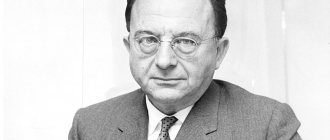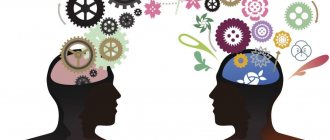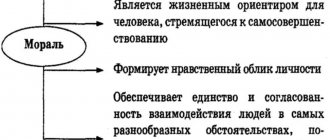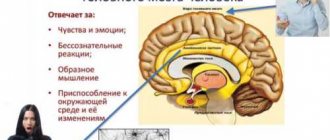Consciousness
Through consciousness, phenomena of the surrounding world are reflected in the human psyche. The area of consciousness includes all knowledge about reality.
Find out what awaits you today - Horoscope for today for all zodiac signs
Due to numerous requests from subscribers, we have prepared an accurate horoscope application for mobile phones. Forecasts will arrive for your zodiac sign every morning - it's impossible to miss! Download for free: Daily Horoscope 2020 (available on Android)
Consciousness enables a person to conduct purposeful activities.
Conscious thought processes are characterized by the following features:
- Forethought.
- Controllability.
- Seriality.
- Easy to understand.
Being conscious means doing what you are going to do and choosing the ways in which you will do it, taking into account the circumstances and your situation.
Through conscious processes a person gains knowledge. The structure of consciousness includes the following cognitive processes:
- Thinking. It allows you to solve emerging issues with the help of knowledge and experience.
- Memory. It stores images of the past, accumulated experience, and allows you to refer to them.
- Imagination. Allows you to build completely new images, come up with new ideas.
- Feel. Responsible for obtaining information about the world using the senses.
- Perception. This is how we ourselves perceive the surrounding reality, our attitude towards it.
The presence of consciousness distinguishes a person from other living beings. Many experiments have been conducted to determine whether animals are conscious. But as a result, it was found that they are not aware of themselves, but perform actions in response to external stimuli.
A manifestation of consciousness is the presence of language, which reflects socio-historical experience.
Self-knowledge can be called one of the highest forms of manifestation of the conscious. This is the ability to direct mental processes to explore oneself.
A person can consciously compare and contrast himself with the world around him, that is, find similarities and differences.
Education and training of people occurs through consciousness.
However, not all processes can be understood and controlled by a person.
Emotions
Now let’s look at what emotions are and why are they needed at all?
Wikipedia gives the following definition:
Emotional process, emotional phenomenon, emotional state, emotion (from Latin emoveo - shocking, exciting), slang. affect (from Latin affectus - passion, emotional excitement) is a psychophysiological process that motivates and regulates activity (behavior, perception, thinking), reflecting the subjective meaning of objects and situations, and is represented in consciousness in the form of experience.
The definition is not very easy to understand, but it also talks about motivation and regulation of actions.
Eastern sage
Indeed, a person’s emotional background plays a decisive role in terms of the possibility or impossibility of solving practical problems in life. We are all capable of a lot if we are in a good, positive mood. A negative emotional state discourages the desire for any activity at all. But the above definition does not explain the essence of the phenomenon.
Emotions are, first of all, the reaction of the human psyche to current, future, or past, but preserved in memory, events of his life.
That is, they (emotions) arise after information processing. Now imagine, the unconscious processes a colossal amount of information of a very wide range. Awareness of the results of this processing is necessary for a person to manage his life. The question arises, how to present the result at the level of consciousness, and even at the pace of events? Obviously, this should be some kind of information concentrate, which can at least initially be assessed in general categories:
- “good” (positive mood),
- “bad” (negative mood),
- “uncertain” (“no” mood).
Emotions are this information concentrate, which is a report of unconscious levels to consciousness about the work done.
Further, if the psyche works well, then the report will be adequate to life. If malfunctions occur in the algorithmic functioning of the unconscious, the consequence may be an inadequate report on the situation that has occurred or is occurring to the person. As a result of this, there are cases when an individual’s soul begins to “scratch the cats,” although objectively one should be happy, and vice versa. All this is a consequence of the distortion, distortion of morality and the individual’s worldview by modern culture. This kind of distortion already occurs in childhood when watching the vast majority of Hollywood cartoons. Read the article about this: “Western versus Soviet cartoons”
Based on the foregoing, the most important task of modern man is to ensure the unity of the emotional and semantic structure of the soul, that is, his adequate perception of what is happening in life, and, as a consequence, the adequate reaction of his unconscious to these life situations. A key role in ensuring it is played by the development of morality and the ability to adjust the psyche in a positive way, regardless of the circumstances. A person is objectively capable of this.
Unconscious
Previously, the human psyche was identified with consciousness. Sigmund Freud was the first to point out the enormous importance of the unconscious in human life and began to study it. Later, the idea of this area was expanded by Jung and Assagioli. The study of the area of the unconscious is still ongoing, and scientists are receiving new and interesting information.
Unconscious processes are those that a person is not aware of, but they influence his judgment, behavior and feelings.
In the human psyche, consciousness is only the tip of the iceberg, and the unconscious is its entire invisible part.
The unconscious is also called the subconscious.
It should be noted that consciousness and subconscious are inextricably linked. Images and ideas can move from one area to another. Thus, skills developed to the point of automatism cease to be conscious of us and pass into the realm of the unconscious. Rules of conduct, words heard from parents and educators in childhood, can develop into subconscious fears and attitudes that a person will not be aware of, but they will control his behavior.
The spiritual component of man
If science can say something significant and concrete regarding the material part of a person, then the spiritual component is closed to science - it cannot be measured by any instruments. The material essence of a person can be understood and science, by studying the genome, is increasingly convinced of how complex the human body is. And although many questions still remain, a lot can be understood here with the help of modern instruments and super-powerful microscopes. But if you look at the spiritual part, at what is often called the “soul,” then even more questions arise here.
Take, for example, such a question as a person’s sleep. Why do all people dream? If sleep is simply a product of human activity, a continuation of daytime experiences, then why does a person often find himself in places in his sleep that he has never seen? Why did D. Mendeleev see a table of elements in a dream, and the correct table at that? And here, involuntarily, philosophers begin to approach what they called the subconscious.
Unconscious mental phenomena
Freud referred to the unconscious as qualities, interests and desires of the individual that are not consciously realized, but are manifested in involuntary actions and mental phenomena. Let's look at some of them:
- Freud paid much attention to dreams. With the help of psychoanalysis, of which he is the founder, Freud tried to decipher the meanings hidden in dreams.
- Involuntary actions include errors and slips. Freud noted that they are often not random, but indicate the secret desires and states of a person. Errors often appear when there is a contradiction between an ulterior motive and a goal; this is the result of the unconscious opposing the conscious. The humorous phrase “Freudian slip” emphasizes that what a person says is not an accident, but a consequence of his mental work.
- Another manifestation of the unconscious is forgetting. A person doesn’t really want to remember something, so he constantly forgets it. Sometimes forgetting is associated with the fact that a person is in a difficult life situation, and this “forgetfulness” is designed to save his psyche from overload.
- Fantasies, dreams, daydreams. People usually don't take them seriously enough, but true desires and intentions may be hidden here.
The unconscious influences all human actions, states, and feelings. People have unconscious thinking, unconscious memory, unconscious sensations and perceptions, etc.
Unconscious phenomena include the following types:
- Habitual actions. Since we learned to walk, we no longer need to think about how to take a step. We move our feet unconsciously. We also unconsciously pronounce sounds and put them into words. At the same time, speech itself is a conscious phenomenon. It happens that the action itself refers to a conscious action, but its components are not realized.
- Accompanying actions. When observing a person, you may notice that he sticks out his tongue when drawing, drums his fingers on the table while waiting, or performs other actions that he is not aware of.
- Unconscious attitudes. We have instincts that force us to react to external stimuli in a certain way. For example, the “fight or flight” attitude helped people survive, when in case of danger a person took off and ran away or fought the enemy.
- Pathological states in the psyche. Some diseases are accompanied by hallucinations and delusions that occur unconsciously.
The subconscious can do anything - John Kehoe
In the seventies of the last century, J. Kehoe deliberately retired to reflect on questions about the activity of the human brain. Being far from the benefits of civilization and drawing information from spiritual and scientific sources, relying on his own experience and personal observations, Kehoe developed a method for developing the power of the subconscious.
“The Subconscious Can Do Anything” John Kehoe created the result of his research - a best-selling book. In his work, John Kehoe shares with readers important techniques that help create a new reality. He talks about ways to activate the limitless resources of the subconscious using examples of famous personalities who have become successful and famous.
Below are several techniques proposed by Kehoe for transforming reality towards success and happiness.
The first way to help achieve the realization of the intended goals from the subconscious, he chose visualization, which consists of mentally imagining oneself in certain circumstances, replaying a situation that has not yet occurred. The method is based on the fact that the individual must imagine himself producing or having what he wants, getting what he wants.
For example, a person dreams of becoming a more confident person. To this end, with the help of imagination, he imagines himself as confident, plays out situations in which he commits courageous actions, communicates freely with strangers, and speaks in front of the public. In other words, a person needs to imagine himself as relaxed, confident, and easily achieving success in situations that in reality cause fear, anxiety, and difficulty.
Thus, John Kehoe, answering the question: “how to change the subconscious using visualization techniques,” recommends performing three steps in sequence. First, it is necessary to clearly define what the individual strives to achieve, for example, to pass excellent exams, become rich, achieve a promotion or reciprocity from his beloved girl/boyfriend. Secondly, you need to relax, take a breath, sit back, take your mind off pressing problems, resting your soul and body. Third, for five minutes you should mentally imagine the desired new reality, as if it had already happened.
During the visualization process, you can endow yourself with any necessary traits and qualities. Practice and persistence are key here. There is no need to expect results tomorrow.
Kehoe considered the development of the consciousness of a successful subject to be another effective method of acquiring a new desired reality. To overcome this path, he identified five steps. The first thing to do, in his opinion, is to inflate your faith in success. This can be achieved by fixing in your own subconscious four basic beliefs that contribute to the formation of faith in success, namely, the world is full of riches, each side of your own life contains countless opportunities, life always brings satisfaction and joy, personal success depends solely on the subject himself .
The second step is finding abundance in the present. Each individual is simply surrounded by abundance. All you have to do is look. Money will not come until a person feels lucky. We need to find that area of life where a person can feel abundance.
The third step is programming yourself for success. You need to learn to see success in everything, to receive joy from contemplating it, regardless of whether it is someone else’s or your own.
The fourth step is self-improvement and self-development. Books on self-improvement, attending trainings and seminars, listening to lectures, and taking online courses will help with this.
The fifth step is to associate one’s own personality with successful people, and it doesn’t matter whether these people are real or fictional characters. Thus, the answer to the question: “how to change the subconscious” lies in daily hard work, training, positive thinking
After all, continuous growth means constant practice.
Thus, the answer to the question: “how to change the subconscious” lies in daily hard work, training, and positive thinking. After all, continuous growth requires constant practice.
Mindfulness
Currently, there are many practices aimed at achieving greater awareness by a person. This allows you to take control of your life and achieve excellent results. In addition, mindfulness helps you achieve inner harmony and find your place in the world.
We are often not aware of our true desires, but are guided by generally accepted stereotypes. Everyone has beliefs imposed by society or loved ones on how to do the right thing and what is wrong and shameful. Therefore, we often do not want to admit even to ourselves our thoughts and aspirations. However, failure to accept oneself leads to internal discomfort, dissatisfaction, and prevents us from achieving results, because in fact, we want something completely different.
Mindfulness practices help you understand yourself, unravel the tangle of emotions and feelings, and put everything in its place. You need to be honest with yourself and admit to yourself your shortcomings. Awareness of the problem is the first step towards solving it.
Understanding the underlying reasons that lead to unconscious actions helps to take control of them.
Some researchers say that we spend most of our lives unconsciously, in the sense that we act out of habit, constantly think about the past or fantasize about the future. However, a conscious attitude towards the present is the key to efficiency and effectiveness of actions.
With the help of mindfulness practices, you can get rid of bad habits. The action, in essence, comes down to pulling a phenomenon from the area of the unconscious into the area of consciousness and working through it. Or, on the contrary, new patterns of behavior are sent into the unconscious, designed to replace the old ones.
Mindfulness practices may include meditation, autogenic training, working with a psychologist, and others.
Influence on ideas and intuition
Experts believe that it is the deep areas of the psyche that are responsible for the so-called “eureka”, which has visited almost every person at least once during their life. Sometimes it seems to people that a new idea seems to appear absolutely out of nowhere, bringing order to all the chaotic thoughts in a completely incredible way. However, in psychology, the conscious and unconscious are considered a single entity that constantly acts in tandem. One cannot function normally without the other.
The same generation of ideas is largely the merit of the unconscious, but their subsequent assessment and selection of the most promising ones are already regulated by the conscious part of the mind. That is why many guides, trainings and experts advise, when solving complex problems, to resort to one time-tested method - to completely abstract from this activity for a while. During this period, the unconscious part will go about its business, and after a certain period of time, while spending leisure time, a person may suddenly find a solution to a complex problem.
Model of structuring the personality psyche
Like any system, the psyche is ordered in a certain way. Let’s say right away that our goal is to describe the structure and functioning of the psyche in a language accessible to everyone. It is important to realize that regardless of whether you are a “simple” person, or an “advanced” shaman or yogi, you are able to safely understand and master the principles of its functioning. The model should be such that everyone individually has the opportunity to use this model in the practice of life.
Model of the psyche accessible to everyone
So, if we consider the psyche as a single algorithmic complex for the perception, processing and exchange of information, we can distinguish three components:
- Consciousness and unconscious levels of the psyche;
- Emotions;
- A set of moral standards.
Each of these components performs a specific function.











